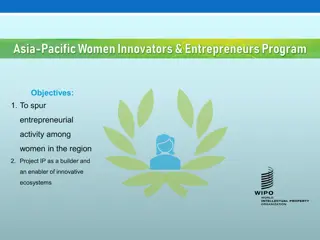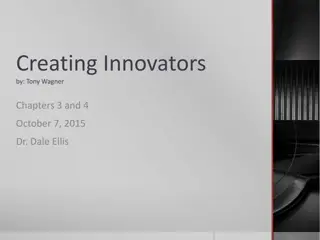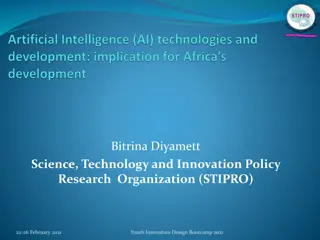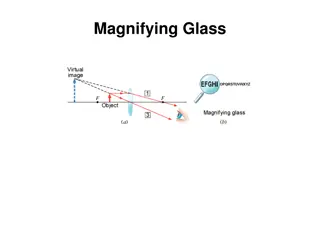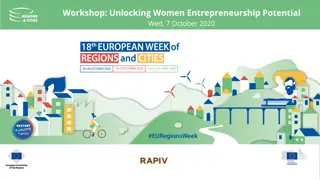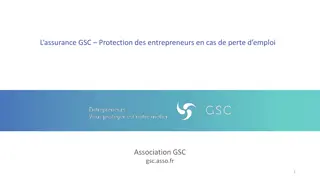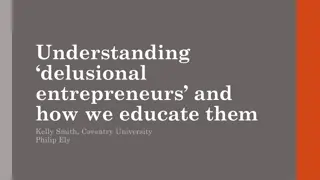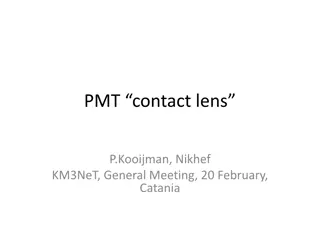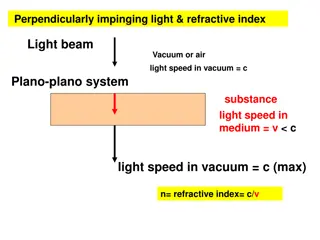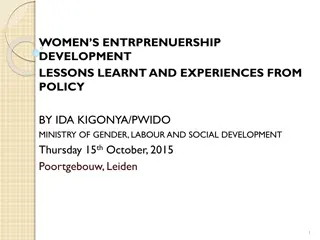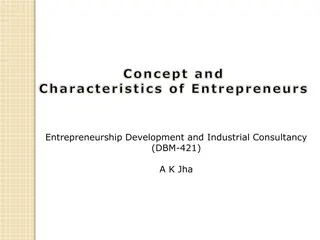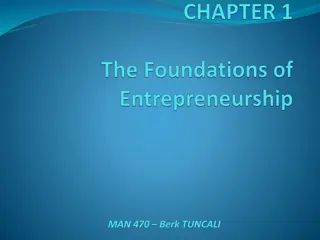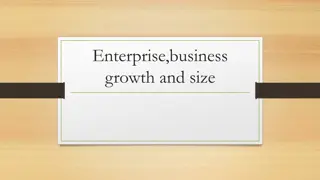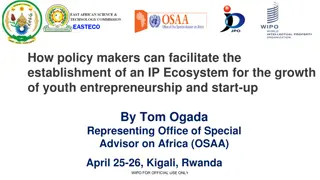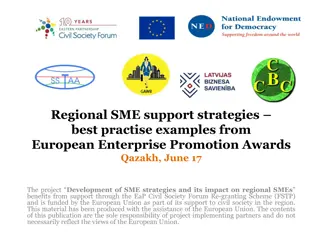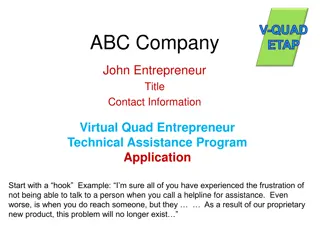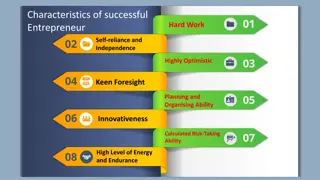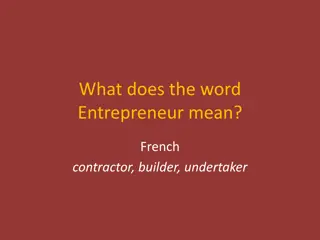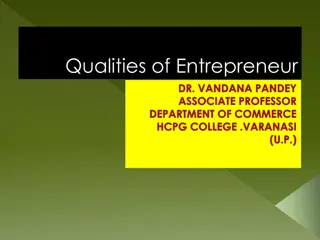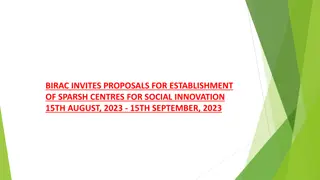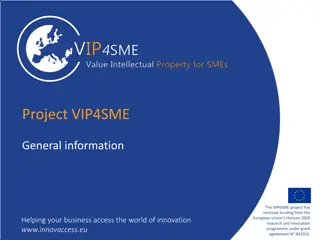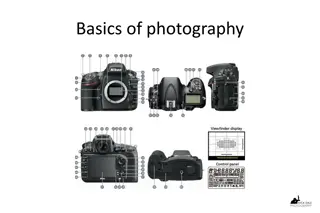Unlocking Success: The Power of Intellectual Lenses for Women Innovators & Entrepreneurs
Explore the Asia-Pacific Women Innovators & Entrepreneurs Program where intellectual lenses are highlighted as crucial tools for success. These lenses help inventors, innovators, and entrepreneurs gain clarity, insight, and vision by collecting and focusing valuable information. Learn how key lenses such as Inventiveness, Applications & Market Relevance, Value Proposition, and Business Model play pivotal roles in shaping innovative ideas and driving commercial success.
Download Presentation

Please find below an Image/Link to download the presentation.
The content on the website is provided AS IS for your information and personal use only. It may not be sold, licensed, or shared on other websites without obtaining consent from the author. Download presentation by click this link. If you encounter any issues during the download, it is possible that the publisher has removed the file from their server.
E N D
Presentation Transcript
WIPO The Asia-Pacific Women Innovators and Entrepreneurs Weekly Program Ideation to Impact The Essential Intellectual Lenses of the Inventor/Innovator/Entrepreneur R.S. Cahoon
Our Discussion Today What is an Intellectual lens ? Why are they important tools for the successful Inventor/Innovator/Entrepreneur A lens collects light and forms images The lens makes things visible by collecting scattered light and transforming it into an understandable form
Our Discussion Today What is an Intellectual lens ? Why are they important tools for the successful Inventor/Innovator/Entrepreneur A mechanism by which something can be seen and understood Like a light lens an intellectual lens collects varied information and brings it into clear focus Used by the inventor/innovator/entrepreneur,l certain key lenses transform scattered information into understanding, insight, and vision for the path forward
The Successful Inventor/Innovator/Entrepreneur uses these key lenses Inventiveness Applications & Market Relevance The Value Proposition The Business Model Each of these lenses provides a tool to gather various and disparate information, and bring it together into a focused, and understandable form
Inventiveness Always the best place to start What is inventiveness ? Two essential components: uniqueness: compared to the prior art the unique features confer some advantage or superior performance compared to existing solutions
Defining an invention.. exactly what it is, and how it works .. why it is unique how it is superior Is the single most important step in the process of commercializing a new technology Unique and Superior = Inventive
The Importance of Inventiveness Inventiveness is the cornerstone of patentability and essential to commercializing new technology Inventiveness = unique +superior/advantages Unique (compared to what?) Superiority/advantages of the unique features Defining Inventiveness of a new technology: carves out the scope of patentability, produces market relevance, and establishes the value proposition
Procedure for Inventiveness analysis 1. Understand & define the invention precisely. 2. Conduct keyword-based, prior art search of patent databases & technical literature. 3. Locate the closest (most similar) patents/articles 4. Carefully compare the independent claims (start with Claim 1) of the closest patents to your invention 5. Determine inventive features 6. Define initial scope of patentability (if any) 7. Reconsider the invention and ALL its aspects after analyzing the prior art 8. Refine understanding and definition of the invention, its inventiveness, and scope of patentability
The Prior Art The Prior Art is all information that that is available to the public in any form before a given date that is relevant to an invention's novelty and inventiveness (non-obvious) If an invention has been described in the Prior Art, or is not inventive/obvious relative to what has been described in the Prior Art, it is not patentable.
Inventiveness Understanding the differences between the prior art and your invention configures the inventiveness of your invention and its potential scope of patentability Patentability scope the PCP Understanding the potential scope of patentability provides the basis for determining the Property Control Position (PCP) PCP is the suite of IP (and bioproperty) that can be used to protect the invention
Inventiveness Patentability scope the PCP Understanding the Inventiveness of an invention is the launch-pad for: scope of patentability formulating other IP strategies applications of the solution the inventiveness offers market relevance the Value Proposition
Applications & Market Relevance Begin with the advantages the inventive features provide Advantages compared to what? What problem(s) do the inventive features solve or what opportunities are created? List the applications where the inventive features are useful Why would someone care about the problem? How much do they care? All this is Market Relevance What are the economics underlying the problem and its solution?
The Unique Value Proposition (UVP) What is it? The benefit(s) the invention will provide .at a cost, that a future buyer (the customer) will perceive as a compelling value Value = Benefits Cost [define and quantify - whenever possible - benefits and costs]
Why is the Unique Value Proposition (UVP) so important? It provides a compelling basis for a business case for the invention It s the basis of the elevator pitch for investors, partners, etc It is the cornerstone of a start-up business plan Writing it transforms the writer
The Unique Value Proposition (UVP) Explains how the invention provides the unique value (specific benefits cost) to a future buyer, compared to alternatives. Is a clear and concise statement that summarizes why someone would buy the product or service based on the invention. Describes how the invention will produce a product or service that will add more value, create more profit, or better solve a problem than current alternatives.
The Unique Value Proposition (UVP) Makes it clear how the invention will solve future users /buyers problems or improves their situation so that profitability is enhanced. Identifies why the technology is superior to the competition (unique differentiation).
What makes a good UVP? Clarity! It s easy to understand. Communicates concrete results that will result from using the technology and its products and/or services. States how it s different (and better) than the alternatives. Avoids hype ( never seen before, amazing miracle product ), superlatives ( best ), and business jargon ( value-added interactions ). Can be read/understood in about 10 seconds. Almost never longer than one maybe two - sentences
UVP Examples Achieves the same level of pest control as current chemistries at 30% cost reduction. Produces materials that exhibit 25% increased life at temperatures above 450 C at a cost comparable to existing high temperature materials. Increases the manufacturing yield of large Li batteries by 50% with no cost increase
UVP Examples Achieves the same level of pest control as current chemistries at 30% cost reduction. Produces materials that exhibit 25% increased life at temperatures above 450 C at a cost comparable to existing high temperature materials. Increases the manufacturing yield of large Li batteries by 50% with no cost increase
UVP Examples A natural topical antiseptic 90% as effective as current chemical antiseptics. A tomato variety that exhibits 50% more solids and 25% more sugar per unit weight than currently available varieties. Reduces scours mortality in new-born calves from 15% to 1.5% at a cost of less than 6 Pesos per animal.
The Business Model A business model describes how an organization creates, delivers, and captures value, in economic, social, cultural or other contexts. The process of business model construction and modification is also called business model innovation and forms a part of business strategy The term business model refers to the plan for making a profit by selling the product or service. It identifies the products or services that will be sold, the identified target market and customers, and anticipates costs to produce and deliver the product or service. What will be sold? Who is the customer? How will the product/service be sold and distributed How will the product be manufactured, packaged, delivered? What customer services pre- and post-sales will be required?
The Importance of Business Model An average invention/technology/product combined with a good Business Model is likely to be successful A great invention/technology/product combines with a poor Business Model is likely to fail A good Business Model can compensate for some flaws in the product/service A bad Business Model can t save the best product
Thank you Q&A


